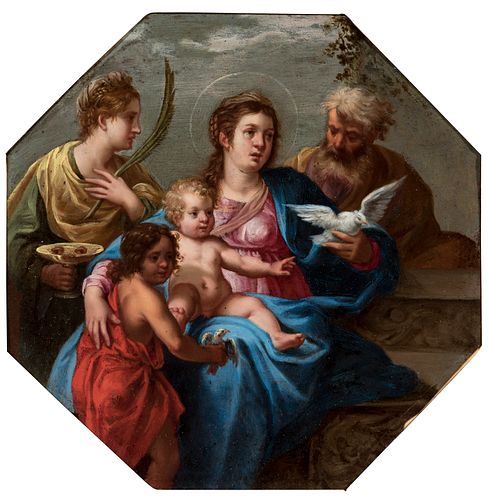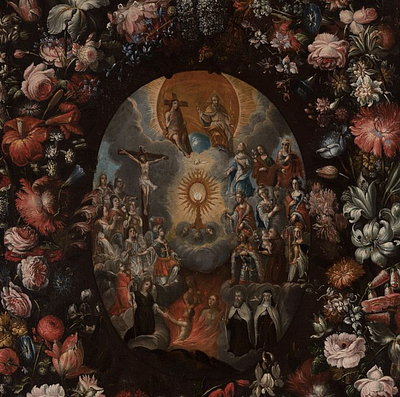Follower of ANIBALE CARRACCI (Bologna, 1560 - Rome, 1609). "Holy family with St. John and St. Lucy". Oil on copper.
Lot 91
About Seller
Setdart Auction House
Carrer Aragó 346
Barcelona
Spain
Setdart Subastas was born in 2004 and is currently the first online art auction in Spain with solidity, prestige and reliability guaranteed by our more than 60,000 users. Setdart has a young, dynamic and enterprising team ready to successfully manage the purchase and sale of art works through custom...Read more
Estimate:
EUR€5,000 - EUR€6,000
$5,208.33 - $6,250
Absentee vs Live bid
Two ways to bid:
- Leave a max absentee bid and the platform will bid on your behalf up to your maximum bid during the live auction.
- Bid live during the auction and your bids will be submitted real-time to the auctioneer.
Bid Increments
| Price | Bid Increment |
|---|---|
| EUR€0 | EUR€10 |
| EUR€200 | EUR€25 |
| EUR€500 | EUR€50 |
| EUR€1,000 | EUR€100 |
| EUR€3,000 | EUR€200 |
| EUR€5,000 | EUR€500 |
| EUR€10,000 | EUR€1,000 |
| EUR€20,000 | EUR€2,000 |
| EUR€50,000 | EUR€5,000 |
About Auction
By Setdart Auction House
Jul 14, 2021
Set Reminder
2021-07-14 06:30:00
2021-07-14 06:30:00
America/New_York
Bidsquare
Bidsquare : OLD MASTERS
https://www.bidsquare.com/auctions/setdart-auction-house/old-masters-7202
Setdart Auction House sofia@setdart.com
Setdart Auction House sofia@setdart.com
- Lot Description
Follower of ANIBALE CARRACCI (Bologna, 1560 - Rome, 1609). "Holy family with St. John and St. Lucy". Oil on copper. Presents frames of the early nineteenth century with damage. Measures: 18 x 18 cm: 31 x 31 cm (frame). In this work the artist has made the representation of the Holy Family, following the sweet and naturalistic ways typical of the Italian school. We see Mary and the Child in the center of the composition, and next to them the figure of San Juanito, located in the foreground and in the background San Juan and Santa Lucia, carrying the palm of martyrdom and the tray with his eyes, elements typical of his iconography. The close attitude between all the characters is used by the author to inspire and indoctrinate the viewer, thus getting him to empathize with religion through a scene of friendly character. In the most common sense of the expression, the Holy Family includes the closest relatives of the Child Jesus, that is, mother and grandmother or mother and nurturing father. In both cases, whether it is St. Anne or St. Joseph who appears, it is a group of three figures. From the artistic point of view, the arrangement of this terrestrial Trinity poses the same problems and suggests the same solutions as the heavenly Trinity. However, the difficulties are fewer. It is no longer a question of a single God in three persons whose essential unity must be expressed at the same time as diversity. The three personages are united by a blood bond, certainly, but they do not constitute an indivisible block. Moreover, the three are represented in human form, while the dove of the Holy Spirit introduces into the divine Trinity a zoomorphic element difficult to amalgamate with two anthropomorphic figures. On the other hand, this iconography was traditionally, until the Counter-Reformation, a representation of the Virgin and Child to which the figure of St. Joseph was added in the foreground. It was not until the reforms of Trent that St. Joseph began to take center stage as protector and guide of the Infant Jesus. At the beginning of the 17th century, at the same time that Caravaggio was breaking away from Mannerist and even Renaissance conventions, a new way of understanding painting emerged in Bologna, thanks to Carracci, which is usually called "eclecticism". It sought to integrate the best of each master, especially Michelangelo, Raphael, Titian, Veronese and Correggio. However, Annibale Carracci's personality led him to evolve towards a very personal classicism, which did not disdain certain Caravaggiesque achievements.
- Shipping Info
-
In-house shipping available. Please inquire at admin@setdart.com.
-
- Buyer's Premium



 EUR
EUR CAD
CAD AUD
AUD GBP
GBP MXN
MXN HKD
HKD CNY
CNY MYR
MYR SEK
SEK SGD
SGD CHF
CHF THB
THB
















